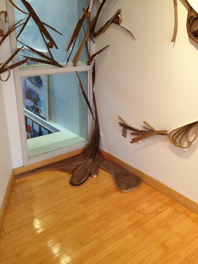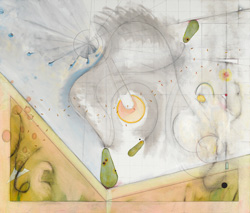Tonight in the Grubbs Gallery, the Trimester 2 Arts Walk will offer an opportunity to see student work in the Grubbs Gallery and hallways of Reed Campus Center, from 6:30 – 7:45 p.m. Come by for fun, food, and art, after the team dinners!

A group exhibit featuring the work of a dozen fiber artists from Southern Connecticut is now on display at the Williston Northampton School’s Grubbs Gallery.
“Double Take: Photo & Fiber,” which includes both fiber artwork and the nature photographs that inspired them, opened March 6. A reception for the artists will be held in the gallery on March 23 from 2-4 p.m.
The collective work was created by Sisters in Cloth, a group who drew their name from a Progressive quilt with a batik motif that they created together. Sisters in Cloth started in Guilford in 2000 and the group’s collective work has appeared in such venues as Haskins Labs at Yale University, Legislative Office Building in Hartford, Garde Theater in New London, and Connecticut Hospice in Branford.
Williston’s Grubbs Gallery opened the second trimester with an exhibit of work from the Fine Arts faculty. Two art teachers, a photography teacher, the gallery’s curator, the costume designer, and an art intern all have personal work on display. Below are artist statements from each faculty member, in which they describe the story behind the art, the focus of their work, and their perspective as artists. The Williston Visual Arts Faculty Show will be on display through January 6 with an opening reception on Sunday, December 15 from 2-4 p.m. See the full gallery schedule here.

Rachel Chambers, Middle School Fine Arts Teacher
I’m a Materials Studies/Installation artist from Philadelphia, PA with a M.F.A. in fiber arts and a M.Ed. in education. My site-specific installations are created with cardboard, knitting, or paper. I start by making small pieces that I then fit into a larger space.
For me, the best part is the way so many interactions take place, which is ironic for me because my process demands such solitude. In order to see the entirety of my composition I have to interact with both my work and the site. Then there’s the interaction with how time of day changes the shadows on the walls and highlights on the medium. There is even an interaction with sound, almost like a recording studio, if there’s enough cardboard surrounding the viewer. Lastly, because of the installation’s size, viewers can usually step into the work; the interaction with the audience has to be taken into account.

“The only way for me to know what I’m doing, and do it again, is to let chance come into the equation,” said Northampton artist Chuck Stern. This may sound contradictory, but, in his work, Stern puts emphasis on the evolving nature of creativity.
“Often it’s the things that are so beautiful that create a block,” he said. Likening his painting process to writing Stern said, “Sometimes you put a sentence down, and it’s so cool, and you just want it there but the whole rest of the story is stuck with this sentence that has no relationship.”
The “blocking” imagery is covered in his art with white paint and then erased, to let the life of the painting continue. But if you look closely, Stern leaves the white paint light enough to, “let the history of the painting show through,” he said.
“I like the way he describes his process so well, and encourages students to slow down and think of their work in terms of visual ‘problems’ to be solved,” said Natania Hume, Grubbs Gallery curator and a member of the Fine and Performing Arts faculty.
When Stern paints he approaches the canvas by asking himself, “What’s next?” In the end he likes his paintings to be cohesive, but during the creative process he views his work as puzzles with a life of their own, he said.
Stern described the way he navigates his paintings as similar to camping before the invention of GPS and cell phones. One student said he liked, “how [Stern) lets go and sees where the painting takes him.”